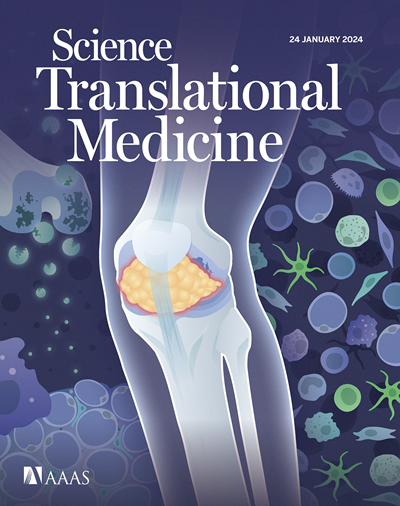An AAV variant selected through NHP screens robustly transduces the brain and drives secreted protein expression in NHPs and mice
IF 15.8
1区 医学
Q1 CELL BIOLOGY
引用次数: 0
Abstract
Recent work has shown that prolonged expression of recombinant proteins after adeno-associated virus (AAV)–mediated delivery of gene therapy to long-lived, ventricle-lining ependymal cells can profoundly affect disease phenotypes in animal models of neurodegenerative diseases. Here, we performed in vivo screens of millions of peptide-modified capsid variants of AAV1, AAV2, and AAV9 parental serotypes in adult nonhuman primates (NHPs) to identify capsids with potent transduction of key brain tissues, including ependyma, after intracerebroventricular injection. Through these screens, we identified an AAV capsid, AAV-Ep+, with markedly increased potency in transducing ependymal cells and cerebral neurons in NHPs. AAV-Ep+’s potency was conserved in three species of NHP, two mouse strains, and human neurons derived from induced pluripotent stem cells. To apply AAV-Ep+ to the treatment of ceroid lipofuscinosis type 2 disease, a lysosomal storage disorder caused by loss-of-function mutations in tripeptidyl-peptidase 1 (TPP1), we used the capsid to package the human TPP1 transgene (AAV-Ep+.hTPP1) and delivered the construct by intracerebroventricular injection into mice lacking TPP1 activity. AAV-Ep+ provided robust and therapeutically relevant TPP1 protein concentrations in these mice, significantly improving tremor and life span. In NHPs, high cerebrospinal fluid (CSF) TPP1 concentrations were achieved after intracerebroventricular delivery of AAV-Ep+.hTPP1 at a total dose of 1 × 1012 viral genomes, which was more than 30× lower than previously reported doses in NHPs. These results suggest that AAV-Ep+ may be a potent vector for gene therapy applications where CSF protein expression is required.
通过NHP筛选筛选的AAV变体在NHPs和小鼠中可以有效地传导大脑并驱动分泌蛋白表达
最近的研究表明,在腺相关病毒(AAV)介导的基因治疗递送到长寿命的室管膜细胞后,重组蛋白的长时间表达可以深刻影响神经退行性疾病动物模型中的疾病表型。在这里,我们在成年非人灵长类动物(NHPs)中对数百万种AAV1、AAV2和AAV9亲本血清型的肽修饰衣壳变体进行了体内筛选,以鉴定在脑室注射后对关键脑组织(包括室管膜)具有有效转导的衣壳。通过这些筛选,我们发现了一种AAV衣壳,AAV- ep +,在NHPs中具有显著增强的室管膜细胞和大脑神经元的转导效力。AAV-Ep+的效力在三种NHP、两种小鼠品系和诱导多能干细胞衍生的人神经元中保持。为了将AAV-Ep+应用于治疗由三肽基肽酶1 (TPP1)功能缺失突变引起的溶酶体贮积紊乱的ceroid lipofuscinosis 2型疾病,我们使用该衣壳包装了人TPP1转基因(AAV-Ep+. htpp1),并通过脑室内注射将构建物传递给缺乏TPP1活性的小鼠。AAV-Ep+在这些小鼠中提供了强大的和治疗相关的TPP1蛋白浓度,显着改善震颤和寿命。在NHPs中,脑室内递送AAV-Ep+后脑脊液TPP1浓度升高。hTPP1的总剂量为1 × 1012个病毒基因组,比以前报道的NHPs剂量低30倍以上。这些结果表明,AAV-Ep+可能是一种有效的基因治疗载体,用于需要CSF蛋白表达的基因治疗应用。
本文章由计算机程序翻译,如有差异,请以英文原文为准。
求助全文
约1分钟内获得全文
求助全文
来源期刊

Science Translational Medicine
CELL BIOLOGY-MEDICINE, RESEARCH & EXPERIMENTAL
CiteScore
26.70
自引率
1.20%
发文量
309
审稿时长
1.7 months
期刊介绍:
Science Translational Medicine is an online journal that focuses on publishing research at the intersection of science, engineering, and medicine. The goal of the journal is to promote human health by providing a platform for researchers from various disciplines to communicate their latest advancements in biomedical, translational, and clinical research.
The journal aims to address the slow translation of scientific knowledge into effective treatments and health measures. It publishes articles that fill the knowledge gaps between preclinical research and medical applications, with a focus on accelerating the translation of knowledge into new ways of preventing, diagnosing, and treating human diseases.
The scope of Science Translational Medicine includes various areas such as cardiovascular disease, immunology/vaccines, metabolism/diabetes/obesity, neuroscience/neurology/psychiatry, cancer, infectious diseases, policy, behavior, bioengineering, chemical genomics/drug discovery, imaging, applied physical sciences, medical nanotechnology, drug delivery, biomarkers, gene therapy/regenerative medicine, toxicology and pharmacokinetics, data mining, cell culture, animal and human studies, medical informatics, and other interdisciplinary approaches to medicine.
The target audience of the journal includes researchers and management in academia, government, and the biotechnology and pharmaceutical industries. It is also relevant to physician scientists, regulators, policy makers, investors, business developers, and funding agencies.
 求助内容:
求助内容: 应助结果提醒方式:
应助结果提醒方式:


